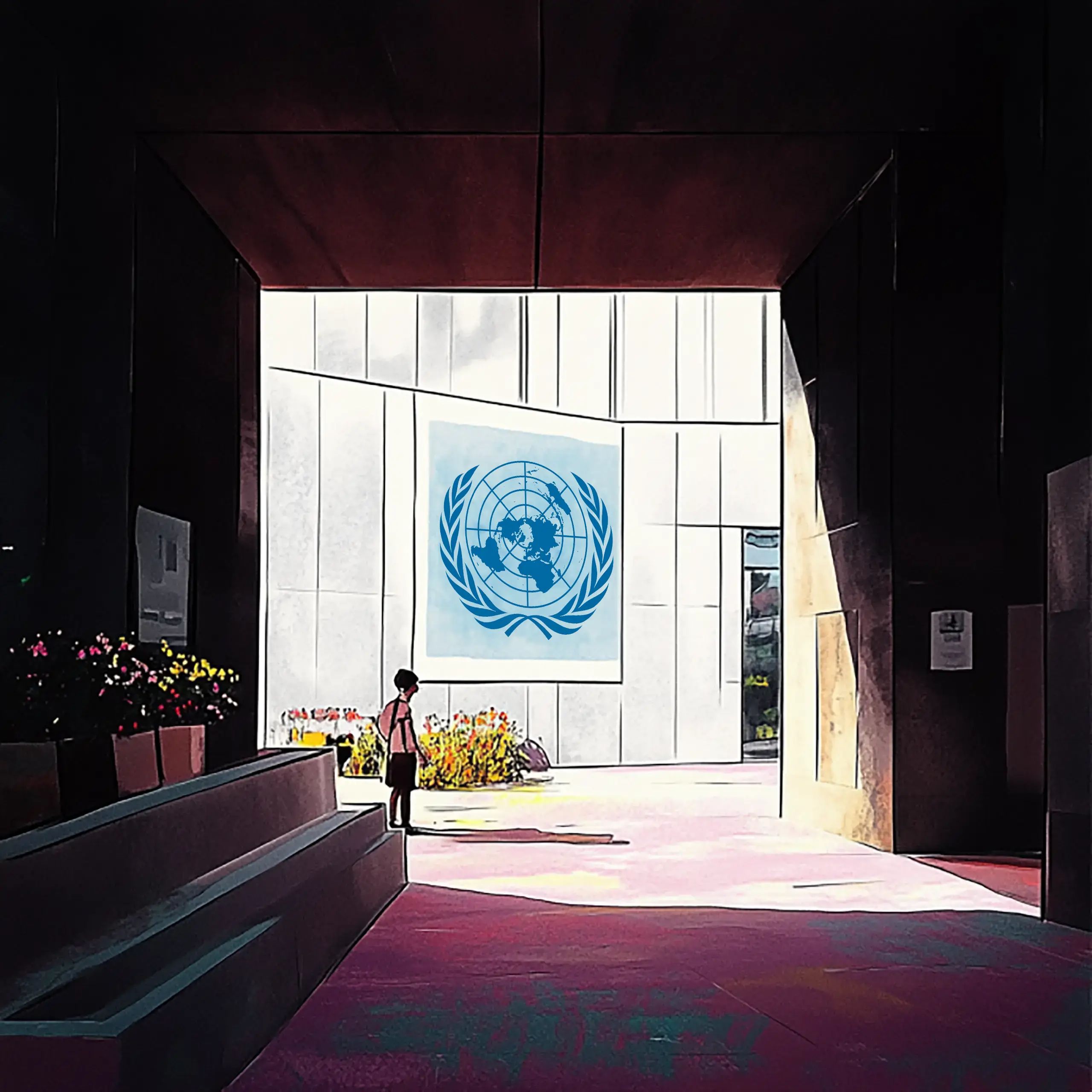International Peace and Security
Pact for the Future – Chapter 2

International Peace and Security
Pact for the Future – Chapter 2
By Our Future Agenda – UN Foundation

A Call for Bold Action
The World Stands at a Crossroads
The chapter sets the stage by highlighting the grave threats that are reshaping the global security landscape. These include the risk of nuclear war, misuse of new technologies, increasing armed conflicts, and violations of the UN Charter, which threaten to destabilize entire regions.
The big message: If we want peace, we need to stick to international law, prioritize diplomacy, and work together as countries and communities.
But it’s not just about preventing wars – it’s about securing a peaceful foundation for the SDGs to succeed. The clock is ticking, and action can’t wait. Communities already suffering from conflict and instability are most at risk if we don’t act quickly.
The world has to choose – do we let chaos spread, or do we step up, fix what’s broken, and build a safer future?

A Call for Bold Action
The World Stands at a Crossroads
The chapter sets the stage by highlighting the grave threats that are reshaping the global security landscape. These include the risk of nuclear war, misuse of new technologies, increasing armed conflicts, and violations of the UN Charter, which threaten to destabilize entire regions.
The big message: If we want peace, we need to stick to international law, prioritize diplomacy, and work together as countries and communities.
But it’s not just about preventing wars – it’s about securing a peaceful foundation for the SDGs to succeed. The clock is ticking, and action can’t wait. Communities already suffering from conflict and instability are most at risk if we don’t act quickly.
The world has to choose – do we let chaos spread, or do we step up, fix what’s broken, and build a safer future?


Key Themes for
Global Transformation

Nuclear Disarmament
Nukes are the world’s biggest threat, and this chapter calls for real, renewed efforts to get rid of them once and for all. If we want security, disarmament is the first step.
Human Rights
True peace means protecting human rights and ensuring justice for all. We need to crush discrimination and create a world where everyone has equal access to opportunities, justice, and safety
Humanitarian Aid
Conflict and instability are pushing millions into crisis. With rising hunger and displacement, the world needs to step up its game in delivering life-saving aid.
Women in Peacebuilding
Women aren’t just affected by conflict – they’re key to resolving it. The chapter pushes for women to play a bigger role in peace and political processes and get the protection they need from conflict-related abuse and violence.
Youth as Peacebuilders
Young people are the present, and they need a seat at the table. Their involvement in peace and security decisions is non-negotiable.
15 Tangible Actions

Action 13: Build Peace and Spend Smarter
Shift money from military budgets to solving the root causes of conflict and funding sustainable development. The Secretary-General will track military spending and its impact on the Sustainable Development Goals.
Action 14: Protect Civilians and Stop the Violence
Innocent people, especially women and kids, shouldn’t pay the price for war. This action demands that countries limit dangerous weapons, deliver aid where it’s most needed, and ensure that war criminals face justice – all with full respect for international humanitarian law.
Action 15: Deliver for the Hungry and Dispossessed
Fighting the root causes of protracted displacement and ending world hunger. Governments need to step up for refugees and displaced communities. Countries facing humanitarian emergencies must also be supported, including through financing, to assist those in need.

Action 16: Solve Conflicts with Diplomacy
Think of the world like a giant sports team, where every country plays a position. When things get tense, diplomacy is like the coach calling a timeout to calm everyone down and get them working together again. Countries are stepping up to solve problems peacefully, like teammates settling their differences before the game falls apart. They’re also creating tools, like early warning systems, to spot potential conflicts before they flare up, just like a coach anticipating a play before it happens. The Secretary-General is the team’s captain, leading efforts to keep everyone on track, making sure the UN is ready to step in and help prevent issues from turning into bigger conflicts, and keeping the Security Council in the loop.
Action 17: Respect the Rule of Law
International law is the backbone of global peace, and when the International Court of Justice (ICJ) makes a ruling, nations must follow through. This action demands that countries respect the decisions of the ICJ to maintain peace and uphold the rule of law.
Action 18: Fund Peace
Think of peace like a house we all live in — it needs a solid foundation and constant upkeep. Countries are coming together to stop violence, like fixing cracks in the walls, especially to protect women and girls from harm. They’re also working to end racism and discrimination, helping communities talk and work together, just like good neighbors do. Nations are teaming up to stop conflicts before they even begin, like firefighters putting out sparks before they turn into wildfires. And to keep everyone safe online, they’re fighting the spread of dangerous weapons and harmful content, while making sure we all still have the freedom to speak and connect.

Action 19: Enable Women at the Peace Table
Women are vital to creating lasting peace, but too often they’re left out of negotiations and political processes. This chapter insists that women must have a seat at the table in all peace processes. It also calls for stronger measures to protect women and girls from violence during conflicts.
Action 20: Involve the Next Generation in Peacebuilding
Young people are the future of peace, and they need to be part of today’s decisions. Nations must involve youth in conflict resolution and peacebuilding. The Secretary-General will track and report on how young people are shaping peace processes worldwide.
Action 21: Reimagine Peace Operations
The world has changed, and so must peacekeeping. UN missions need clear strategies, strong funding, and solid exit plans to tackle modern-day conflicts. The Secretary-General will lead a review of peace operations to ensure they’re fit for the future.

Action 22: Secure the Seas
The seas are facing rising threats like piracy and illegal trafficking, and nations need to act fast. By sharing information and boosting cooperation, countries can protect global shipping routes and secure the world’s oceans for the future.
Action 23: Fight Terrorism Together
Terrorism remains a global menace, and it takes a united effort to combat it. Countries must focus on addressing the root causes of extremism while preventing terrorist groups from misusing technology. The Secretary-General will ramp up coordination to strengthen the fight against terrorism.
Action 24: Stop Organized Crime
Transnational organized crime and illegal money flows can be a big danger to global peace, human rights, and development. In some cases, these crimes are even linked to terrorist groups. To fight this, we need to step up efforts with stronger strategies like prevention, early detection, and better law enforcement. It’s important to involve everyone, from authorities to community leaders. Countries will work together to stop these crimes, especially ones involving technology, and support the creation of a new United Nations agreement to fight cybercrime.

Action 25: Eliminate Nuclear Weapons
A world without nuclear weapons is the ultimate goal, but the risk of nuclear conflict remains high. Countries will work together to stop an arms race and promote lasting peace. They will honor existing treaties that ban nuclear weapons in certain regions and make sure no one uses or threatens to use them. Nations will also strengthen international rules on disarmament and non-proliferation to stop nuclear weapons from spreading. Finally, they will speed up their efforts to meet their commitments to disarmament and create more nuclear-weapon-free zones around the world.
Action 26: Revive Global Disarmament Talks
Countries are coming together to tackle the spread of dangerous weapons and keep people safe. The UN is leading the charge, pushing for a big global meeting to focus on disarmament. The goal? A world free of chemical and biological weapons, with anyone who uses them held responsible. To prevent threats, countries will improve how they detect and respond to dangerous biological risks, whether natural or man-made. They are also working to keep deadly weapons from falling into the wrong hands by cracking down on the illegal trade of small arms and ammunition. This is about making the world a safer place for everyone.
Action 27: Use Technology Responsibly
Countries are coming together to make sure new tech, like space exploration tools and advanced weapons, is used only for good. They’re working to prevent an arms race in space and creating rules for super-smart weapons that can operate on their own. Plus, they want everyone around the world to have access to the benefits of new digital tech, closing the digital divide. Countries are also keeping a close watch on artificial intelligence in military use to stop things from getting out of control. It’s all about making sure technology helps protect people and creates a safer future for everyone.

International Cooperation and the Path Forward
International cooperation is not a choice – it’s a necessity. Peace and security are global issues, and threats that undermine stability and safety can’t be tackled alone. The chapter calls for deeper partnerships across governments, international organizations, and regional bodies to address the evolving challenges of today’s world.
Diplomatic efforts, preventive measures, and enhanced peacekeeping operations are essential to avert future crises. The United Nations is urged to lead the charge, coordinating global efforts and ensuring that commitments are followed through.
Future milestones are crucial to track progress. Key steps include ramping up efforts on global peace initiatives and supporting women and youth in peacebuilding. A major target is the Secretary-General’s independent study on Youth, Peace, and Security, set for completion by September 2026.
Achieving these goals by 2030 is vital for a peaceful and secure world. The time to act is now, and our future hinges on the world’s united push for real change.

Get the Full Scoop
If you enjoyed our decoded version of the Pact for the Future and want to delve into more detail on the recommendations, you can immerse yourself in the full version here:
To find out more about the Summit of the Future, click here.






